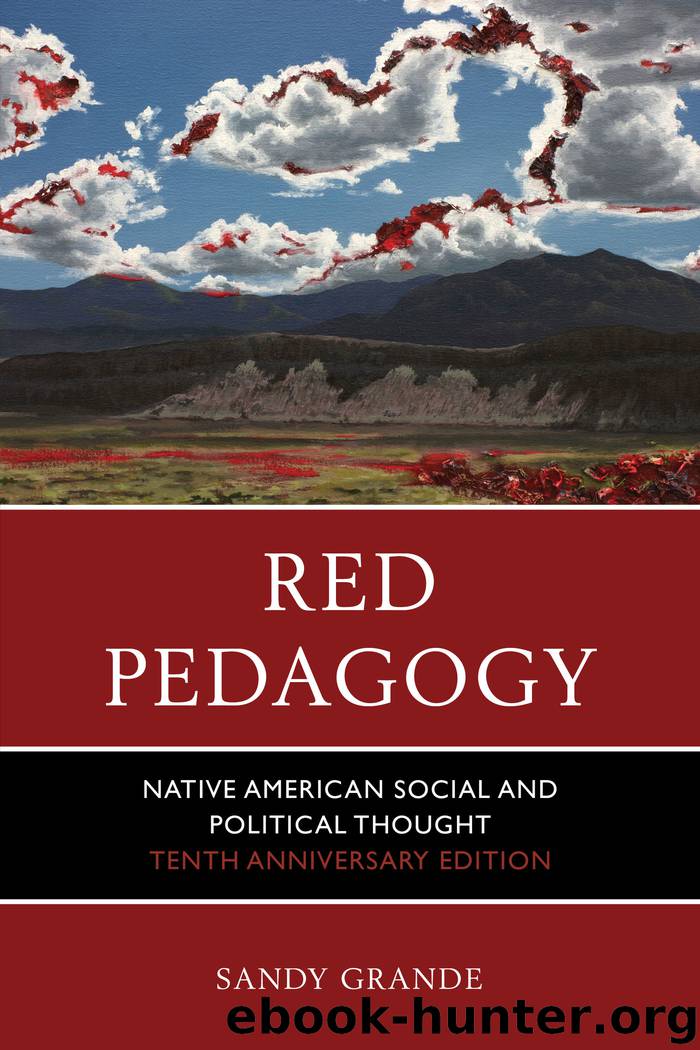Red Pedagogy by Grande Sandy;

Author:Grande, Sandy;
Language: eng
Format: epub
Tags: undefined
Publisher: Rowman & Littlefield Publishers
Published: 2012-03-02T16:00:00+00:00
Cultural Imperialism
“Indian Country” persists as both a metaphoric space and a geographic place, one that profoundly shapes the subjectivities of those who traverse it. Specifically, the relationship between American Indian communities and the surrounding (white) border towns not only shapes the ways Indians perceive and construct the whitestream but also their views of themselves. Thus, while reservation borders exist as vestiges of forced removal, colonialist domination, and whitestream greed, they are also understood as marking the defensive perimeters between cultural integrity and wholesale appropriation. They are the literal dividing lines between “us” and “them,” demarcating the borders of this nation’s only internal sovereigns. Though the power of this status is continually challenged, American Indians have retained enough of their plenary powers to establish tribal courts, tribal governments, and tribal police forces; the borders of such communities are thus material realities and not simply “signifiers” of Indian Country.
That being said, tribal sovereignty remains deeply fettered by the fact that most reservation economies are only sustainable with the infusion of outside capital (Deloria and Lytle, 1984). This dependency on outside capital generates a subordinating effect, often leaving American Indians at the mercy of venture capitalists and whitestream do-gooders. Emissaries of white justice, private entrepreneurs, and New Age liberals thus descend on reservation communities, forging lucrative careers at the same time they engage in “charitable” practices. Indeed, most of the business people, teachers, principals, doctors, and health care professionals in reservation communities are white and most of the laborers, minimum-wagers, underemployed, and unemployed are American Indian. Safely bivouacked in their internal and external compounds, they wield power and broker services by day and, by night, retreat back into the comforts of their bourgeois border towns.
Though the social and political impact of “do-gooders” is significant, culture vultures and venture capitalists wreak even more damage as they aim to sell everything Indian, from Native art and music, to spirituality and DNA. Indigenous scholar Laurie Ann Whitt (1998) faults late-capitalist views of ownership and property for sustaining cultural imperialism, which she sees as “the central historical dynamic mediating Euro-American/Indigenous relations.” In particular, she identifies the following two central assumptions of property and ownership as underlying relations of imperialism: (1) the belief that ownership is individually held, and (2) the belief that individual owners have the right to privacy, in both the maintenance and the economic management of their property. Whitt maintains that these “politics of property” have provided the premise under which U.S. imperialists have seized everything from American Indian lands to spiritual traditions and cultural practices (1998, p. 148).
Specifically, the first assumption—that ownership is individually held—is used to negate tribal (collective) “ownership” over Indian lands, spiritual practices, and cultural traditions: If (1) ownership of such “goods” cannot be traced back to a single individual, then (2) no “one” must own them. This logic is insidiously and explicitly employed by whitestream proprietors to transfer commonly held Indigenous “property” to the realm of public domain. Once American Indian “property” is reclassified as material of the public domain, the second assumption of U.
Download
This site does not store any files on its server. We only index and link to content provided by other sites. Please contact the content providers to delete copyright contents if any and email us, we'll remove relevant links or contents immediately.
The Secret History by Donna Tartt(18951)
The Social Justice Warrior Handbook by Lisa De Pasquale(12170)
Thirteen Reasons Why by Jay Asher(8848)
This Is How You Lose Her by Junot Diaz(6837)
Weapons of Math Destruction by Cathy O'Neil(6220)
Zero to One by Peter Thiel(5736)
Beartown by Fredrik Backman(5682)
The Myth of the Strong Leader by Archie Brown(5461)
The Fire Next Time by James Baldwin(5386)
How Democracies Die by Steven Levitsky & Daniel Ziblatt(5175)
Promise Me, Dad by Joe Biden(5117)
Stone's Rules by Roger Stone(5053)
A Higher Loyalty: Truth, Lies, and Leadership by James Comey(4909)
100 Deadly Skills by Clint Emerson(4882)
Rise and Kill First by Ronen Bergman(4741)
Secrecy World by Jake Bernstein(4703)
The David Icke Guide to the Global Conspiracy (and how to end it) by David Icke(4658)
The Farm by Tom Rob Smith(4468)
The Doomsday Machine by Daniel Ellsberg(4452)
